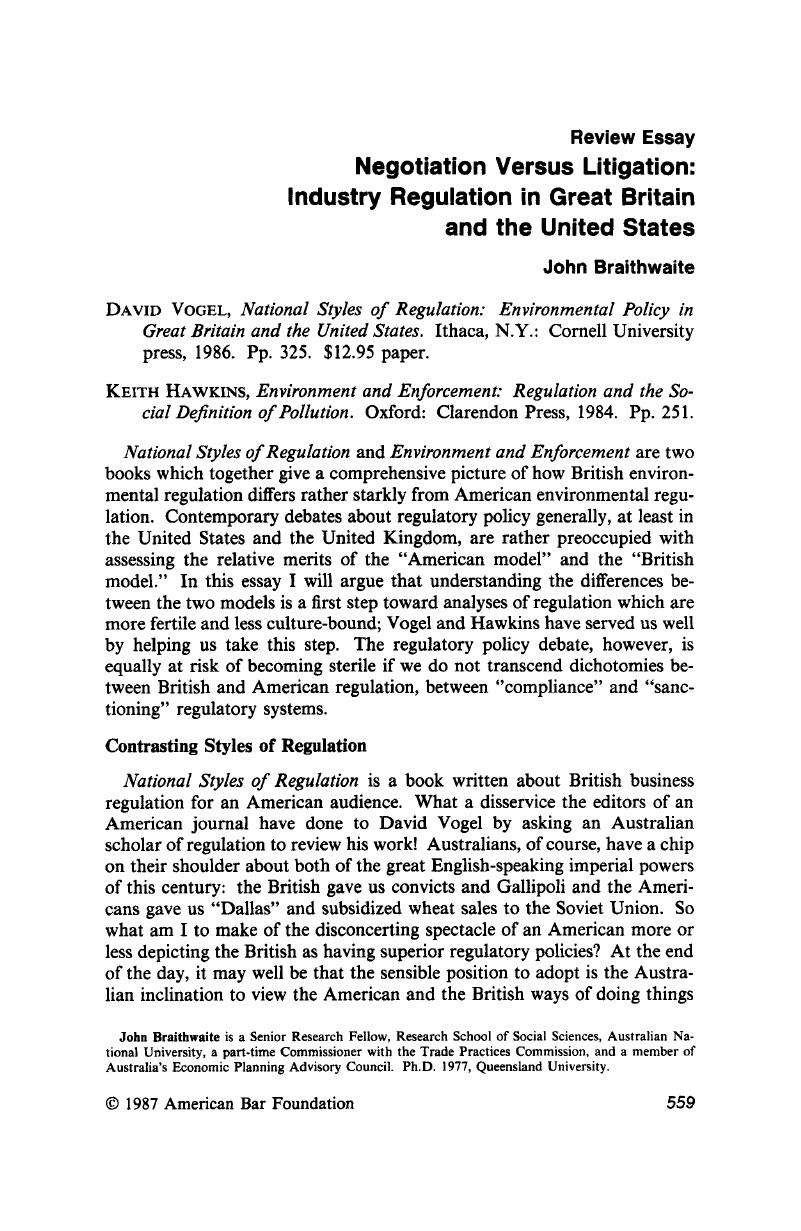Published online by Cambridge University Press: 20 November 2018

1 E. Bardach & R. A. Kagan, Going by the Book: The Problem of Regulatory Unreasonableness: 1982).Google Scholar
2 Hawkins (at 196) points out that when the police deal with states of affairs and with a familiar population, their enforcement approximates a compliance rather than a sanctioning model. It might be overstating things, however, to suggest that the police turn away from sanctioning in these circumstances to the extent that business regulators almost invariably do.Google Scholar
3 S. Kelman, Regulating America, Regulating Sweden: A Comparative Study of Occupational Safety and Health Policy (1981).CrossRefGoogle Scholar
4 In our multivariate analyses of the policies and practices of 96 Australian business regulatory agencies, we identified a cluster of agencies we labeled “benign big guns.” These were agencies that carried bigger sticks than all other agencies but also walked more softly than most other agencies. P. Grabosky & J. Braithwaite, Of Manners Gentle: Enforcement Strategies of Australian Business Regulatory Agencies (1986).Google Scholar
5 See J. Braithwaite, To Punish or Persuade: Enforcement of Coal Mine Safety (1985).Google Scholar
6 McCormick, A. E., Rule Enforcement and Moral Indignation: Some Observations on the Effects of Criminal Antitrust Convictions upon Societal Reaction Processes, 25 Soc. Probs. 3039 (1977).CrossRefGoogle Scholar
7 Coleman, J. S., Social Theory, Social Research and a Theory of Action, 91 Am. J. Soc. 1309–35 (1985).Google Scholar
8 E. H. Sutherland, White Collar Crime (1949).Google Scholar
9 A review of data from the United States, Australia, Israel, Britain, Finland, Sweden, Norway, Denmark, the Netherlands, Kuwait, India, Indonesia, Iran, Italy, Yugoslavia, Poland, and Costa Rica is available in Grabosky, P., Braithwaite, J., & Wilson, P. R., The Myth of Community Tolerance Toward White Collar Crime, 20 Austl. & N.Z. J. Criminology 33–44 (1987); for evidence to 1982, see Braithwaite, J., Challenging Just Deserts: Punishing White Collar Criminals, 73 J. Crim. L. & Criminology 723–63 (1982).CrossRefGoogle Scholar
10 D. Nelken, The Limits of the Legal Process: Landlords, Law and Crime (1983). Nelken's study is a British example of how community stereotypes characterized exploitative behavior by profiteering commercial landlords as blatant intentional harassment when, in fact, the latter behavior was comparatively rare. The real problems which tenants faced were rendered immune from regulation partly as a result of the stereotype.Google Scholar
11 Senior water board man, quoted by Hawkins at 194.Google Scholar
12 Rossi, P. H., Simpson, J. E., & Miller, J. L., Beyond Crime Seriousness: Fitting the Punishment: o the Crime, 1 J. Quantitative Criminology 59–90 (1985).CrossRefGoogle Scholar
13 J. Frank, F. T. Cullen, & L. F. Travis, Sanctioning Corporate Crime: Public Support for Civil and Criminal Intervention (paper to Annual Meeting of Midwest Criminal Justice Association, 1984).Google Scholar
14 Grabosky & Braithwaite, Of Manners Gentle (cited in note 4).Google Scholar
15 M. Dukes & I. Lunde, Review of the Restrictive Actions Under the Australian Drug Regulatory System, Med. J. Austl., May 15, 1986, at 412–15.Google Scholar